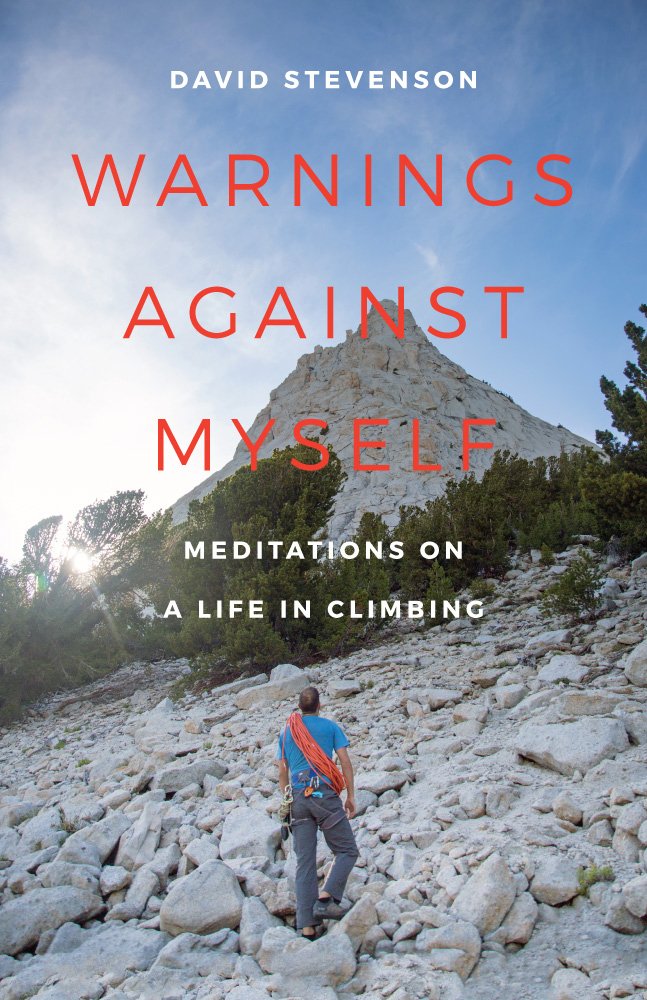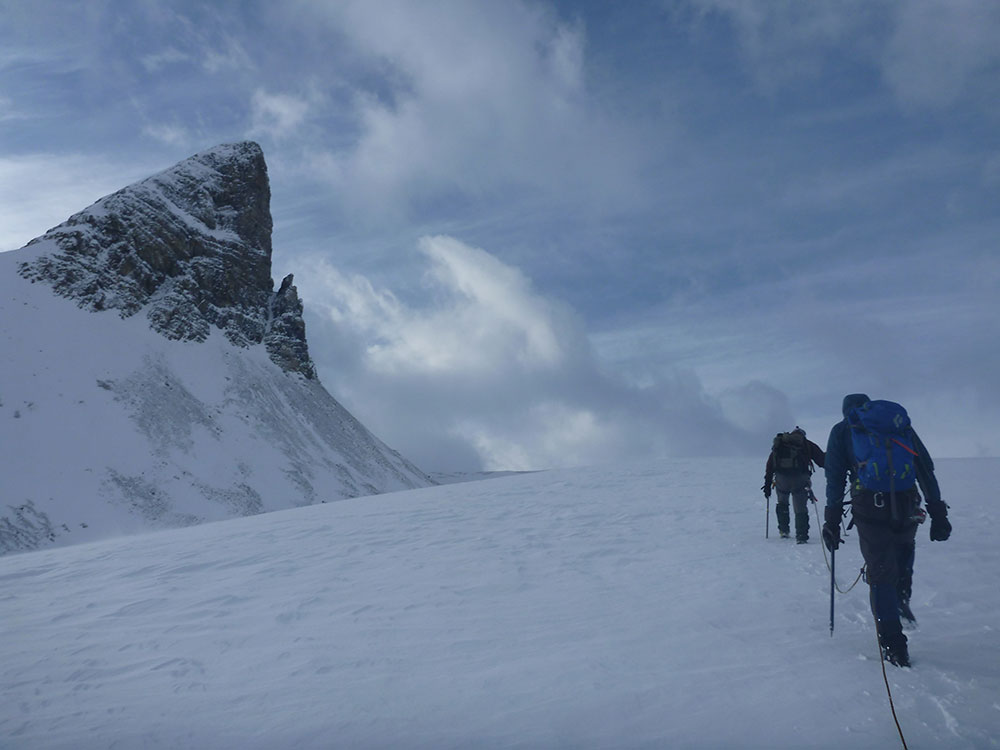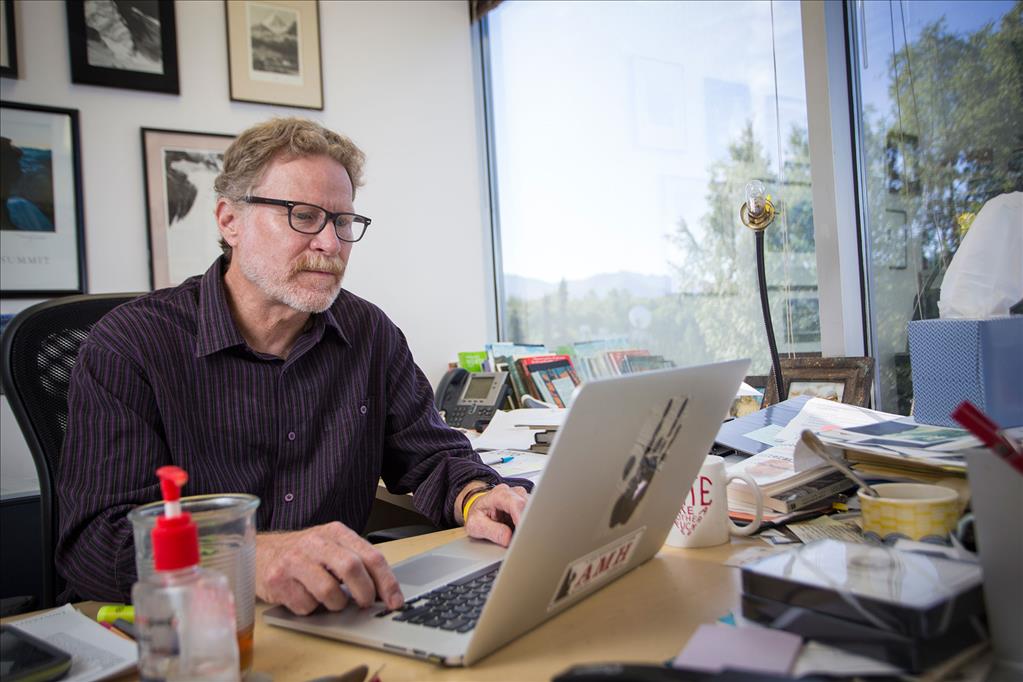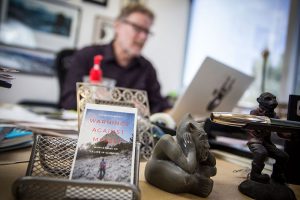CWLA's David Stevenson: The gems among us
by Kathleen McCoy |

Book jacket for 'Warnings Against Myself' by David Stevenson.
So many good things happen under the wide umbrella that is UAA, it's hard for campus scribes to keep up. Check that; it's impossible. A university is a rich river of talent, teaching, discovery, exploration and expression. Tenacious effort happens all the time.
David Stevenson's book of essays, Warnings Against Myself: Meditations on a Life in Climbing, published by the University of Washington Press in March 2016, is one fine example. Earlier this spring, David read on campus to celebrate its publication.
David also published a short fiction collection, Letters from Chamonix, in 2014. It won the Banff Mountain Book Award for Fiction and Poetry. He has worked more than two decades as the book review editor at The American Alpine Journal, and also taught at the Kachemak Bay Writers' Conference. Currently he directs the Low Residency M.F.A. Program at the University of Alaska Anchorage.
As that program swings into its intense teaching-mentoring phase this week, we spotlight his latest book. [Don't miss the nine nights of literary readings, featuring state and national literary talents, plus fresh work from M.F.A. students. Readings are free and open to the public (July 10-19, ARTS 150, 8 p.m.)]
ON Warnings Against Myself
David's collection of 21 essays tells of his own time in the mountains over the course of three decades. The stories book-end in Alaska, opening with him here in 1977 at age 24 climbing Mount Kennedy in the St. Elias Range, and closing in 2013 at age 60, crossing the Harding Icefield in Kenai Fjords National Park.
His essays are a generous overture into the private world of a thoughtful mountaineer. He shares perspectives and tells stories about this sky-bound endeavor that has managed to hook him for a lifetime. Glory and delight, as well as superstition and foreboding, color the work. Along the way, he introduces us to several of his close climbing partners, a few heroes, his two boys and his never-quite-understanding-this-climbing-thing wife and life partner. These personalities and their attitudes make the stories intimate.

David Stevenson along on a mountaineering trip with friends. (Image courtesy of David Stevenson)
Thirteen of the pieces appeared in other publications between 1990 and 2013. In Warnings, he freshens many of them with a short post-script update or an addendum bearing a new thought. The new endnotes make for a satisfying coda.
Knowing how busy David is this week, we thank him generously for this conversation. We asked him to touch lightly on six areas: the collection's title, audience, life balance, his how-to process, gifts that writing brings, and women (or their lack) in the mountains. Here are excerpts from our conversation, edited for clarity. David's remarks are in italics.
ON TITLES
I was curious about the foreboding nature of the book's title. Should we be worried that David can't be trusted in the mountains? He laughed at that.

David Stevenson, going up. (Photo courtesy of David Stevenson)
It really comes from one of the first anecdotes in the opening story [also titled Warnings Against Myself]. In that story, I am hearing about this other dangerous person who climbs mountains and he has my same name. I was being warned against him, but it resonated like I was being warned against my own weaknesses or desires.
An early subtitle of the book was listed as "Memoirs of a superstitious mountaineer." David explains.
That subtitle came from the original editors. They invented it for the first essay when it appeared on its own, without consulting me. Which is never how I saw that essay myself. But then, it's sort of accurate. There is an essay later in [Warnings] called Superstitious. And so, it is a little bit of a theme for me, I think.
Later, after I mentioned the freakish accident of one famous Alaska climber, David said:
A lot of the accidents are freakish. [Sigh]. You do put yourself out there, to the possibility of freakish things happening. But what is the alternative-not go out? Stay on the couch? I am conservative and safe, but I am still out there.
ON AUDIENCE
Doing a bit of research on David's literary career surfaced a blog post written by M.F.A. program students in the summer of 2015. They expressed appreciation for his writing mentorship, and chose to highlight one quote selected from David's own blog, I May Be Some Time. Here's the quote:
"Thinking about your audience, I think, is for 'careerists' and technical writers and undergraduates in composition courses. Thinking about your audience is not for artists, or even wannabe artists such as myself."

David Stevenson at work in his office at UAA. He directs UAA's CWLA Low Residency MFA program. Writers and mentors are on campus this week. (Photo by Ted Kincaid / University of Alaska Anchorage)
The question of art and audience intrigues me. At galleries, I gravitate to the artist's statement: Please, help me understand your work. And the act of successfully selling a book means you have to have some sense of audience, or at least your publisher does.
Moreover, I'm not a climber and possess no desire to get to the top of anything, yet I still felt welcomed into this book. Without knowing the places or gurus he refers to, I found David a benevolent guide. How did he manage that?
You know, it is a really interesting question. When I first started writing those essays, no one was really interested in them. Most of what is written about mountaineering is simple trip reports: I did this on this route. Usually the ones published are groundbreaking new routes, new mountains, more difficult things.
I don't do any of those things. I am a plodder. I climb, I am busy at it, but I am not at the cutting edge of anything. The kinds of essays I am writing are literary. They don't come from the mountaineering tradition so much. And the book is published by a university press, not a mountaineering press. They were able to read it the way I hoped it would be read. Now, whether it will find an audience, who knows. It is early to say...
Did your editors discuss your audience?
No, we were just on the same wavelength. They hope for a wide audience. The ads they placed were in Harper's Magazine and Creative Nonfiction magazine. So that gives you a sense who they hope will find their way to this book.

Tiny cards feature the book title, next to a gargoyle on David's desk. (Photo by Ted Kincaid / University of Alaska Anchorage)
Your approach makes me think of Oliver Sacks or Atul Gawande, writing about humanity through their medical practices. It's just their lens.
That's what I hope for. Basically, what every writer is asking of their readers is-well, come live in my head for a while. That's it.
On the opposite end of the spectrum is writing for the marketplace. And asking yourself, 'what can I write that can sell.' I just think that's backwards. That's just not going to work. It's not going to produce great work. You have to go with your instincts and your heart.
So editors don't call you and say, 'Hey David, can you do this thing in Alaska for us? We have an audience and we want to feed it.'
(Laughter). No one calls me.
Would you do it if they did?
I don't know. I have never done anything like that. I can't imagine it. I am really protective of my writing time. I basically want to write what I want to write. It's very different than writing on spec or on assignment.
ON LIFE BALANCE
The M.F.A. students' blog post also queried David on balancing writing with life. David responded: "...balancing between being a writer and, well, just about anything else, a caring human being who functions as smoothly as he can in the world: that's the hard thing to balance. How do I do it? When I [do] it at all, it's with great difficulty."
I wanted him to continue.
I am very slow. That book, and even my collection of fiction, they were both written over 25 years. The writing is trickling out-one story and one essay a year. Just trickling out.
I am over 60. I've been writing for a long time, and books are just appearing now. I have a big fat novel [Forty Crows] that I wrote and I'm not able to place yet with a publisher. But I wrote that when my kids were still in junior high and high school. I literally wrote it one page a day while the rest of the house was sleeping. One page a day, every day...never missing a day. From 5:30-7 a.m.
How did that feel? Did that feel right?
It felt like the only possible way to get the work done. But also interesting. I did not always know where the novel was going to go. But I made myself go somewhere with it and it made the book more interesting.
Who is it, Robert Frost, who says, 'No surprise for the writer, no surprise for the reader.' That book ended up better because of the way I wrote it. I think it still needs an editor. The editor thinks about audience. An editor wants a certain length and pacing in a certain way. That's just the reality of the reading world.
ON HOW-TO AND PROCESS
Of course, I had the classic questions: When do you write? How do you write? How do you remember all those details from your climbs? How do you recreate them so vividly?
I do take notes. I am a note taker. I tend to write about the experiences pretty long after them. Things percolate, which is really interesting.
Not everyone does it the same way. Saturday I was up Peak Three [with two other writers]. Three writers climbing a mountain. Those guys stopped every five minutes to write stuff down. I NEVER do that. Both of them did it. And the whole time they're having this philosophical discussion. And I'm like, 'Let's move it along.' They were always behind me because they were so full of ideas and it was so funny hiking with them, they were sort of writing as they go.
I'd be afraid I couldn't remember detail.
When you are out in the mountains, even with other people, you are inside your own head the whole time. You're too out of breath to talk, or they are 20 feet away from you. So you are thinking, 'why am I doing this? what am I getting out of this.'
I also go into the mountains a lot and I don't write about it. I am out there all the time. So some of the things I write about, these are thoughts I have had over many trips and they are just going into this one essay. It is still definitely nonfiction.
So what is your workday process like?
When the house was chaotic, I really got into the habit of writing in the office at the university. I am an early riser. I attribute it to that old habit of writing early in the morning before anyone was awake. So now, sometimes I get to work really early, before anyone else is in the building. I can get more done in an hour and twenty minutes than I can in a whole day.
Do you ever have resistance against your own work?
I used to have resistance. It's so easy for other stuff to fill the space. But as I get older I'm more conscious of the clock running out. I don't have that problem. I am good at getting to work.
But I never was prolific. I write at a slow pace and I think about things a long time. I don't consider it procrastination. I used to think I was a procrastinator, but then I realized I am doing so much writing in my head. It is not procrastination. It is thinking.
It's also a luxury. If I was working in the coal mine every day, I wouldn't have the energy. To just be able to do the work, you are already coming from a privileged position.
Was it hard to look at old work, old essays? Sometimes that's not so fun.
I was surprised that I still liked these essays. A corollary to that is people want me to read from the book at public events. I don't want to. I want to read new stuff, what I am working on now. The newest piece in that book is three years old now.
So I am moving on. I love it as a book, but it's history to me... People say, 'Read from the book...' And I think, 'YOU read from the book.' And here's what I am doing now.
ON WOMEN IN THE MOUNTAINS
I could only recall the mention of a handful of women in David's stories. Are women really that rare in the mountains? He writes that women 'don't call us to the heights, but bring us back down from them.' Is this a conundrum? Should this space be more shared? Are there remnants of a boys' club?
That's a fair question. Climbing has never been completely a men's club. Historically women have been there. Barbara Washburn, she just died last year, she was the first woman to climb Denali. Did you ever read anything about Dora Keen? She did the first ascent of Mount Blackburn. The Anchorage Museum has all her papers and photographs. That would be a great exhibit to curate.
But over my life I have really only climbed with a handful of men. Really, women aren't in the book because they are not part of my experience.
There are fewer [women], certainly, but climbing is now broken into so many sub genres. There is Himalayan. Alpine, traditional rock and sport rock climbing. Some women really excel at sport climbing because their strength-to-weight ratio can be very high. One of the best rock climbers is Lynn Hill. She was a gymnast. She has done things men can't repeat.
But people have their own strengths and interests. Women gravitate toward what suits them. Suffering is not everyone's cup of tea. (Laughter)
ON WHAT'S NEXT
I am working on a couple of things. I have new work coming out in Alpinist, a big long piece, really different for me, an historical piece with a lot of research. A lot of my work is more personal.
But this is about Wrangell-St. Elias and its history. [Alpinist] does features on the human history of a particular mountain. So I am doing one on Mount Kennedy. I climbed there in the '70s.
I am using it as an excuse to go to Haines Junction and hang out at park headquarters. I'm going to look at their expedition records. I'll go in early September. The essay is due at Christmas and I've already done a lot of the legwork. I plan to walk up the drainage we walked up in 1977, until I get to the glacier. Because that does not require anything but bear awareness.
And I am also doing a braided hybrid essay that is a very literary response to a book by a woman named Maggie Nelson. It's a letter to her, a one-sided correspondence. Climbing is only about 20 percent of it.
Was she a climber?
No. Not at all. So the essay is not about climbing, there's just a thread of it in there. It is a meditation on the color blue. It will be in the Alpinist in the fall, probably. You can hear it. I'll be reading it next week [Tuesday, July 19, 8 p.m., Fine Arts Building, Room 150].
Thanks for the conversation!
Written by Kathleen McCoy for the UAA Office of Advancement
 "CWLA's David Stevenson: The gems among us" is licensed under a Creative Commons Attribution-NonCommercial 4.0 International License.
"CWLA's David Stevenson: The gems among us" is licensed under a Creative Commons Attribution-NonCommercial 4.0 International License.









